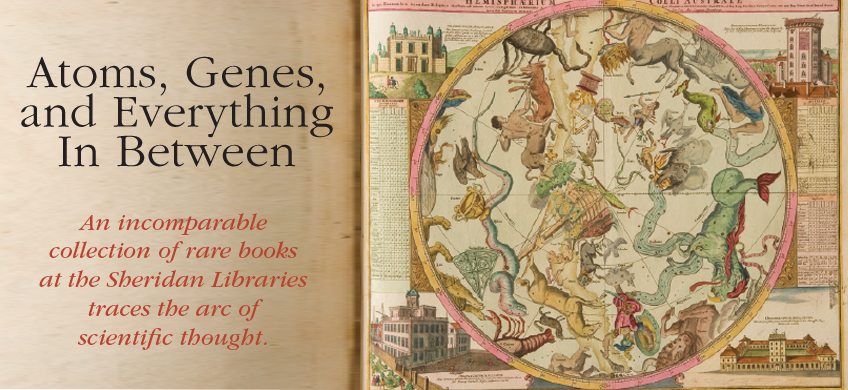
Aristotle, De Caelo (On the Heavens), published in 1495
A third edition of a copy modified by St. Thomas Aquinas hearkens to 330 B.C., when Aristotle posited that there was evidence of a round Earth. This artifact includes some manuscript notes hand-scribbled in the margins by a previous owner, as well as Aquinas’ medieval commentary surrounding Aristotle’s ancient Greek text. Aristotle observed that seafarers traveling south saw the southern constellations rise above the horizon instead of staying on the same plane, as would be expected if the horizon were flat. What’s more, he noted, Earth’s shadow on the moon during lunar eclipses always has rounded edges, more evidence of a spherical Earth. Aristotle also foresaw there must have been an event—what we now know as the Big Bang—that set the universe in motion, something he termed a “prime mover.” Fixed stars were, in fact, part of a system that was constantly moving, and had been since the beginning of time. Aquinas thought that the “prime movers” behind the heavens were angels, making Aristotle’s observations suitable for the Vatican. The Hinkes Collection’s other Greek offerings, adapted during the era of printing, also tell historians a lot about how people viewed science and reason. A 1570 copy of Euclid’s Elements of Geometry published in London includes a preface written by polymath John Dee. Using a foldout page, Dee attempts to put all the knowledge of nature onto one sheet of paper. “That was the ambition of the Renaissance scholar,” says Havens. “John Dee was emblematic of the idea that one man could understand everything about everything.”
Galileo Galilei, Istoria e Dimostrazioni intorno alle macchie solari e loro accidenti (History and Demonstrations Concerning Sunspots and Their Properties), 1613
Hinkes, writing in a catalog for the 2004 exhibit, noted that Istoria was the book that began to fundamentally turn science in a Copernican, heliocentric direction. Galileo’s observations “helped to convince the scientific community that Copernicus’ and [Johannes] Kepler’s harmony of the cosmos was close to the truth,” he wrote. The first edition, published in Rome, is one of three Galilean works in the collection. Its printers used a then emerging etching process that exposed copper plate to acid, allowing for levels of detail that were essential to accurately reproducing what Galileo saw through his telescope. The book was likely owned by a “poor scholar,” says Havens. It is bound by animal skin—a sign, perhaps, that the intellectual could afford an expensive book written for a small audience of learned people, but not expert leather binding. “It was expensive to be a scholar in those days,” Havens adds. The text lays out Galileo’s belief that the geocentric concepts of Aristotle and Ptolemy could be thoroughly disproved. An experimenter long before the book’s publication, Galileo had discovered the moons of Jupiter and noted that they orbited around that planet and not Earth, counter to the Aristotelian model. Istoria “is where he started making public his views on heliocentrism,” says Portuondo. “It started him off on the path to further discovery, but also toward the censors of the Vatican.” After Istoria, Galileo progressed to more controversial treatises that led him to recant proven fact. He died 28 years after Istoria was published, after living for several years under house arrest.
Sir Isaac Newton, Philosophiae Naturalis Principia Mathematica (Mathematical Principles of Natural Philosophy), 1687
In his seminal treatise on gravitation, known among bibliophiles simply as “The Principia,” Newton put forth the idea that the Earth and the heavens are subject to the same laws, completely overturning distinctions made by Aristotle. “Some people would say this is the beginning of modern science because of that unification involving gravity,” says Portuondo. “Newton showed the value of using mathematical models to work out natural laws.” But he hadn’t yet unveiled the calculus he created to develop those laws—a necessity for getting through his tough science problems. This particular copy, a first edition published and authorized by British diarist Samuel Pepys, was originally owned by someone named Jacob Burn. “He probably didn’t read it—because he couldn’t easily do the problems without a firm understanding of Newton’s calculus,” says Havens, who plans to do some investigation to learn more about the book owner. “I want to know who Jacob Burn was. This is detective work. You literally have to take out your magnifying glass to find clues as to who the owners of these books were. I’ll go through the alumni directories for Oxford and Cambridge to see if there is any discernible connection between him and Newton. Was he a friend of Newton’s? Did he have an office near his at Cambridge?” Establishing provenance does more than nail down who bought a book and when. It can tie the book to a place and time and give historians an idea of how it was originally used. Even without more information on Burn as of yet, this copy represents “perhaps the rarest and certainly the most valuable volume in the collection,” Havens says. “It’s already known as ‘The Hinkes Principia.’”



